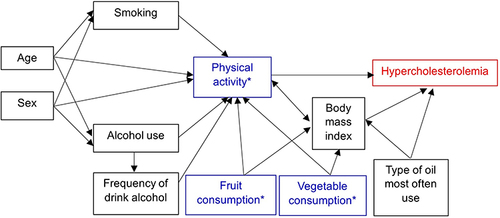Dear editor
The results of a study of the factors that influence the occurrence of hypercholesterolemia in adults have attracted our attention. It was found that there were 7 factors, namely: age, smoking use, alcohol use, fruit consumption, type of oil most often used, body mass index and physical activity; while 3 other factors, namely sex, frequency of drinking alcohol and vegetable consumption were not proven to be factors that influence the occurrence of hypercholesterolemia.Citation1
These findings are very important for efforts to improve adult health in Ethiopia, especially related to efforts to reduce the prevalence of hypercholesterolemia. However, are we sure that the last three factors do not affect the occurrence of hypercholesterolemia? Is the frequency of drinking alcohol and consumption of vegetables not related to hypercholesterolemia? Is it possible that these factors affect hypercholesterolemia indirectly?
Researchers used regression analysis, so it is assumed that the effects of factors were tested simultaneously on the occurrence of hypercholesterolemia. Logically, several factors may have an indirect effect on the occurrence of hypercholesterolemia, through intermediate factors, for example vegetable consumption affects physical activity; then physical activity affects the occurrence of hypercholesterolemia. We illustrate a framework of inter-factor relationships that is still open for editing (), which can be used to explain the direct and indirect effects of each factor. In this case, the influence of each factor is different, in the sense that some are risk factors, such as alcohol consumption and smoking behavior; however, there are also protective factors, such as consumption of vegetables and fruit. Therefore in , the appearance of protective factors is distinguished from risk factors.
Referring to similar problems on different objects,Citation2–4 we suggest that further analysis be carried out to prove the direct and indirect effects of each factor using Smart-PLS.Citation5 Furthermore, we suggest that the results of this further analysis can be published in the same journal; and the new findings obtained can certainly be one of the considerations for relevant stakeholders, in order to reduce the prevalence of hypercholesterolemia in Ethiopia.
Disclosure
The authors report no conflicts of interest in this communication.
References
- Belete AK, Kassaw AT, Yirsaw BG, et al. Prevalence of hypercholesterolemia and awareness of risk factors, prevention and management among adults visiting referral hospital in Ethiopia. Vasc Health Risk Manag. 2023;19:181–191. doi:10.2147/VHRM.S408703
- Nugroho HSW, Suparji S, Martiningsih W, Suiraoka IP, Acob JRU, Sillehu S. A response to “Effect of integrated pictorial handbook education and counseling on improving anemia status, knowledge, food intake, and iron tablet compliance among anemic pregnant women in Indonesia: a quasi-experimental study” [Letter]. J Multidiscip Healthc. 2020;13:141–142. doi:10.2147/JMDH.S247401
- Susatia B, Martiningsih W, Nugroho HSW. A response to “Prevalence and associated factors of musculoskeletal disorders among cleaners working at Mekelle University, Ethiopia” [Letter]. J Pain Res. 2020;13:2707–2708. doi:10.2147/JPR.S281683
- Nugroho HSW, Alvarado AE, Mercado MA. Psychological status of primary medical staff during the COVID-19 outbreak [Letter]. J Multidiscip Healthc. 2021;14:1181–1182. doi:10.2147/JMDH.S318246
- Garson GD. Partial Least Squares: Regression and Structural Equation Models. Asheboro: Statistical Associates Publishing; 2016.

